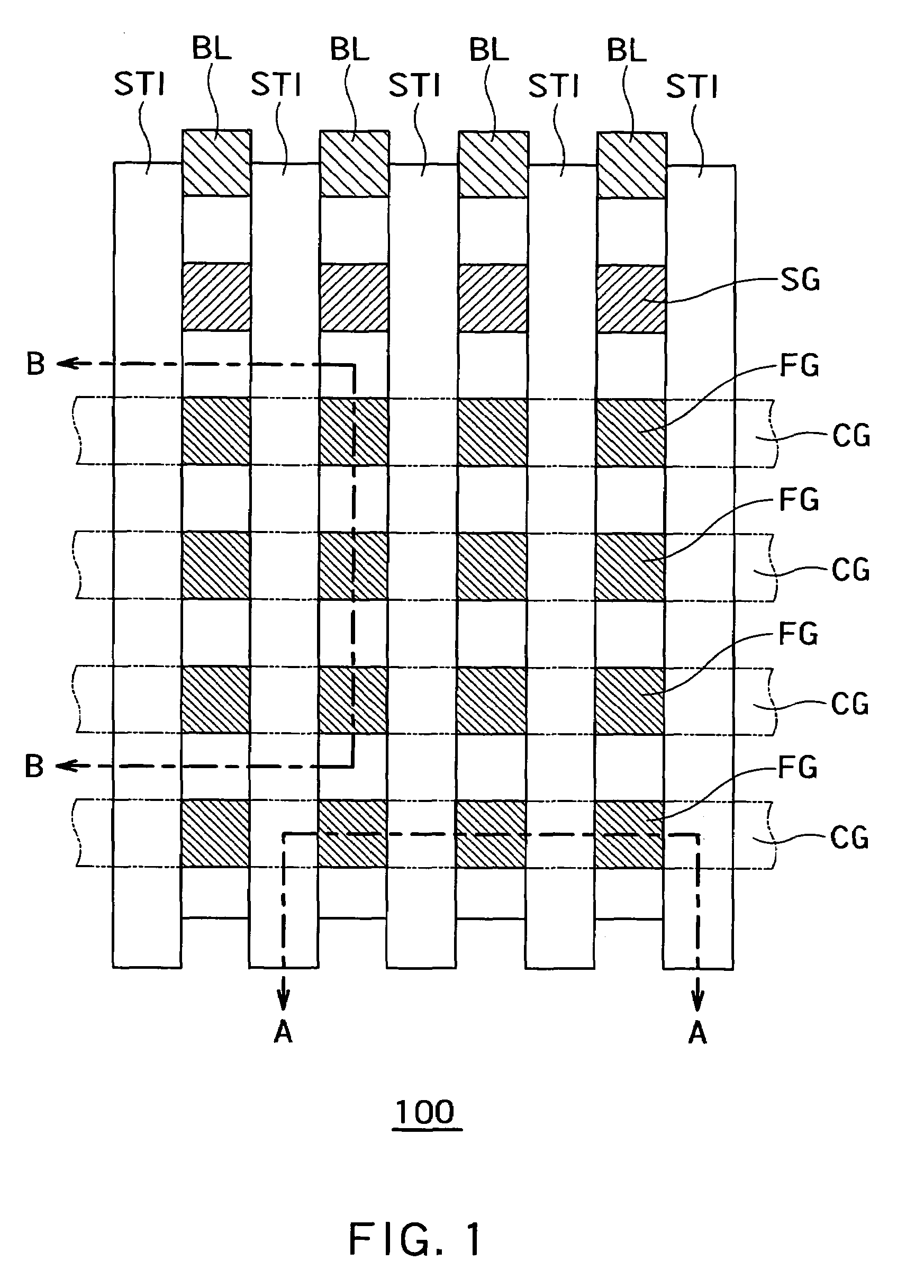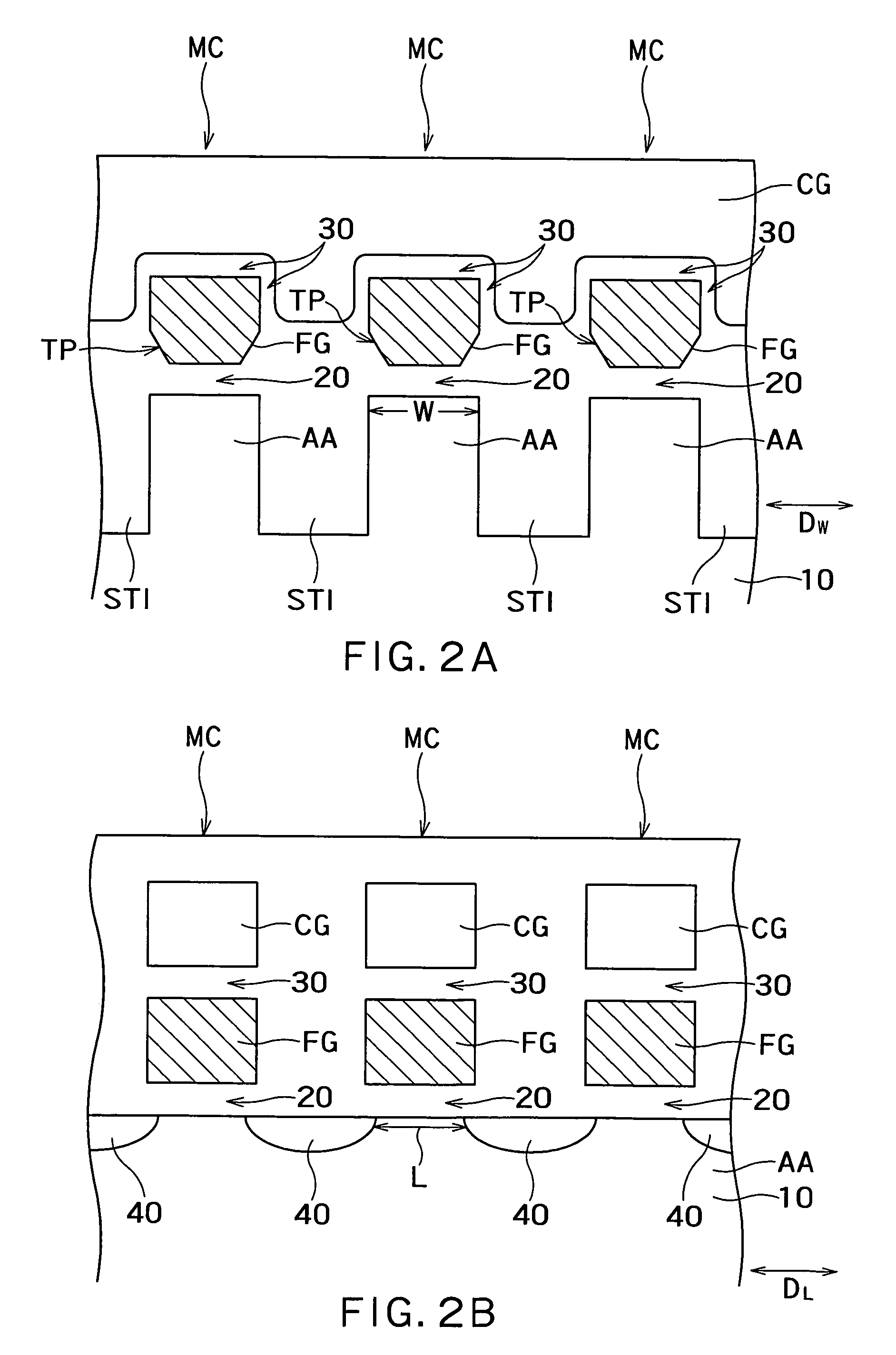Nonvolatile semiconductor storage device and manufacturing method therefor
a semiconductor storage device and non-volatile technology, applied in the direction of drying machines, lighting and heating apparatus, furnaces, etc., can solve the problems of data write failure and interference between memory cells, and achieve the effect of reducing interference between memory cells and easy control of capacitive coupling ratio
- Summary
- Abstract
- Description
- Claims
- Application Information
AI Technical Summary
Benefits of technology
Problems solved by technology
Method used
Image
Examples
first embodiment
(Second Modification of First Embodiment)
[0071]FIG. 11 is a sectional view showing the second modification of the first embodiment according to the present invention. In this modification, only one of two side walls of each floating gate electrode FG is etched by oblique etching. As described above, even if each taper TP is formed only at one of two side walls of the corresponding floating gate electrode FG, the width of the lower hem of the floating gate electrode FG becomes narrower than the width of the corresponding active area AA. Accordingly, the same effects as in the first embodiment can be obtained. According to this modification, it is only necessary to etch one of two side walls of each floating gate electrode FG by RIE. Thus, the manufacturing cost can be suppressed.
Second Embodiment
[0072]FIGS. 12 to 14 are sectional views showing the flow of a method of manufacturing a NAND-type flash memory 100 according to the second embodiment of the present invention. FIGS. 12 to 14...
second embodiment
(Modification of Second Embodiment)
[0077]The second embodiment has been explained as a method of forming each taper TP at two side walls of the corresponding floating gate electrode FG in a section taken in the channel width direction DW. However, if etching in a direction DL is performed by RIE using the same reactive gas, similar tapers are automatically formed in a section taken in the direction DL as well. If the etching in the direction DL is performed by RIE using a reactive gas with a low reactivity to Ge, no tapers are formed in a section taken in the direction DL. As described above, in the second embodiment as well, a direction in which tapers are formed can be selected. The second embodiment is also advantageous in terms of manufacture in that there is no difference in the number of steps required for RIE between a case wherein tapers are formed in both sections taken in the directions DL and DW and a case wherein tapers are formed in either one of sections taken in the d...
third embodiment
[0083]FIGS. 19(A) and 19(B) are sectional views of a NAND-type flash memory 200 (to be also simply referred to as the memory 200 hereinafter) according to the third embodiment of the present invention. FIG. 19(A) is a sectional view taken along the line A-A shown in FIG. 1; and FIG. 19(B) is a sectional view taken along the line B-B shown in FIG. 1. In the third embodiment, recesses C are formed in side walls of active areas AA in a section taken in a channel width direction DW, as shown in FIG. 19(A). With these recesses C, the width of at least a part of the sides (body) of each active area AA is narrower than that of the top surface of the active area AA, in a section taken in a direction perpendicular to a direction in which STIs extend. Each recess C is formed at a depth equal to that where an off-leak current flows in the active area AA. More specifically, the depth is ideally equal to or deeper than that where an extension of a diffusion layer is located. Accordingly, an off-...
PUM
 Login to View More
Login to View More Abstract
Description
Claims
Application Information
 Login to View More
Login to View More - R&D
- Intellectual Property
- Life Sciences
- Materials
- Tech Scout
- Unparalleled Data Quality
- Higher Quality Content
- 60% Fewer Hallucinations
Browse by: Latest US Patents, China's latest patents, Technical Efficacy Thesaurus, Application Domain, Technology Topic, Popular Technical Reports.
© 2025 PatSnap. All rights reserved.Legal|Privacy policy|Modern Slavery Act Transparency Statement|Sitemap|About US| Contact US: help@patsnap.com



